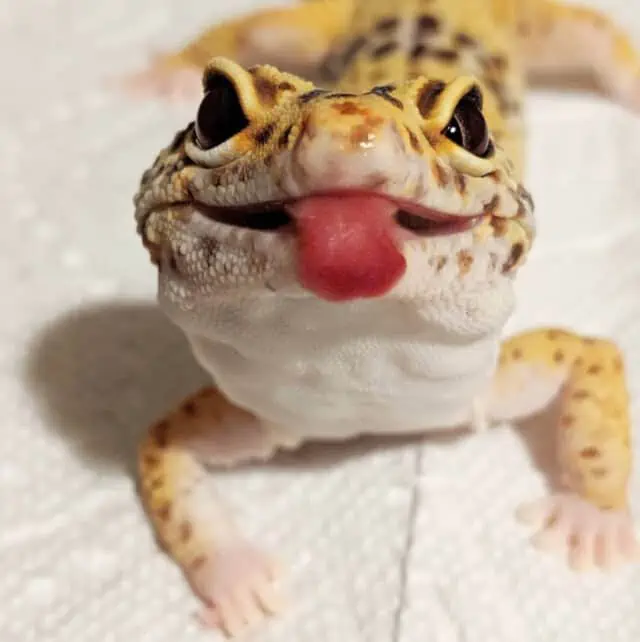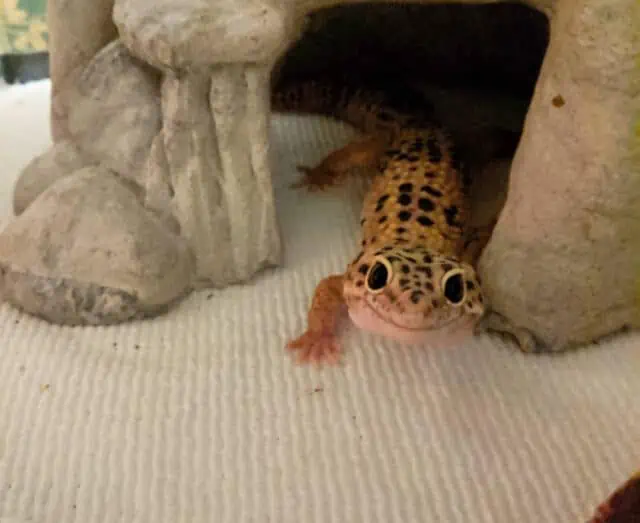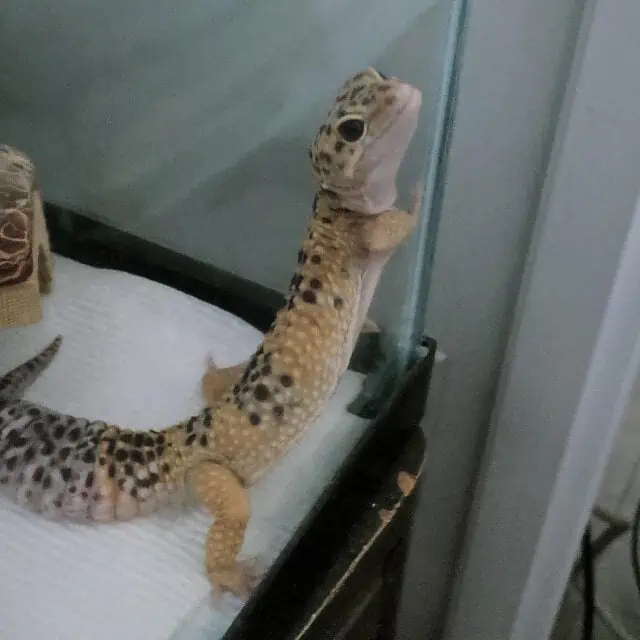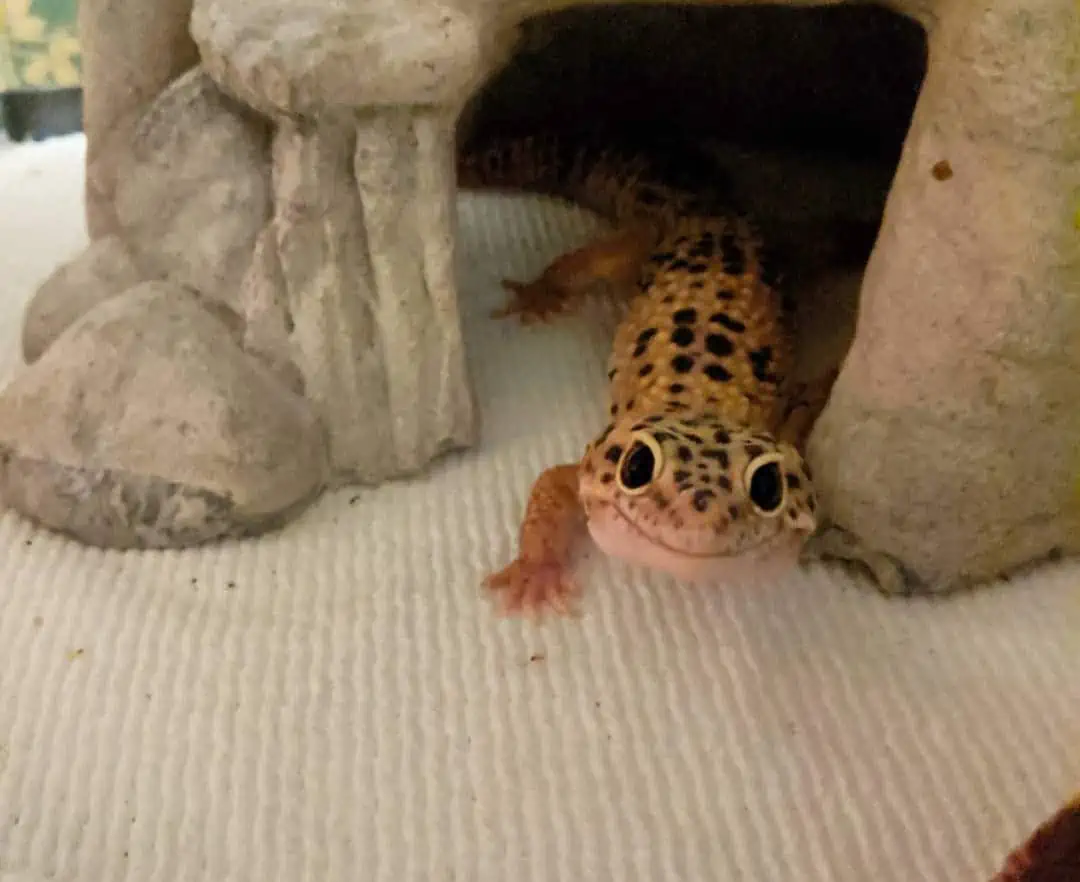When it comes to ensuring the health and happiness of your Leopard Gecko, one of the most crucial decisions you’ll make is selecting the appropriate bedding.
Much more than just the floor beneath their feet, the right substrate can impact everything from your pet’s physical well-being to its behavioral patterns.
It’s not merely about aesthetics or how your terrarium looks; it’s about replicating a habitat where your Leopard Gecko feels at home.
Benefits of Choosing the Right Leopard Gecko Bedding
Selecting the ideal bedding for your Leopard Gecko isn’t a mere act of decoration; it’s a critical step in their care regime. The substrate under their feet interacts with them daily, influencing everything from their physical health to their mental well-being.
Making the right choice can mean a world of difference, leading to a flourishing, spirited gecko who thrives in its environment. On the other hand, an improper selection could pose challenges and even health risks.
Health Benefits

When it comes to our cherished Leopard Geckos, health remains at the forefront of concerns. Surprisingly, something as simple as bedding can either be a shield against potential ailments or, unfortunately, a catalyst for them.
- Prevention of Skin Infections: A moist and unclean substrate can become a breeding ground for bacteria and fungi. These microorganisms can latch onto your gecko’s skin, leading to infections. A well-chosen bedding that’s easy to clean and doesn’t retain excessive moisture can keep such threats at bay.
- Reduced Risk of Respiratory Issues: Dusty or overly fine substrates can be inhaled by geckos, potentially leading to respiratory problems. By opting for a non-dusty, breathable bedding, you ensure your gecko’s airways remain clear and healthy.
- Avoidance of Impaction: Impaction is a severe health concern where indigestible materials from the substrate get lodged in the gecko’s digestive tract. Especially in young geckos, this can be life-threatening. Safe substrates that are non-toxic and less prone to being ingested inadvertently can prevent such dire situations.
The connection between Leopard Gecko health and substrate safety is undeniable. Ensuring the substrate in your terrarium is appropriate doesn’t just make for a prettier home; it’s an act of health prevention.
Comfort and Behavior
The ambiance of a Leopard Gecko’s terrarium plays a pivotal role in their overall disposition and demeanor. Just as we humans have our preferences for comfort, so do these reptiles. A bedding choice that mirrors their natural habitat can significantly influence their behavior, often for the better.
Stress Reduction: An unsuitable substrate can be a source of continual stress for geckos. This can manifest in them becoming reclusive, aggressive, or even refusing to eat. A comfortable, familiar bedding, on the other hand, can instill a sense of security, leading to a more relaxed and confident gecko.
Encouraging Natural Behavior: A bedding that resonates with their native terrain encourages natural behaviors such as digging, exploring, and basking. Witnessing these behaviors is not only a joy for the owner but also a sign of a content and stimulated gecko.
Better Rest: Just like us, geckos need their rest. A comfortable substrate allows them to snuggle down and get quality sleep, ensuring they remain active and alert during their waking hours.
Activity and Play: Geckos are naturally curious creatures. Bedding that offers variability, like different textures or hiding places, can be a source of entertainment and exercise for them, contributing to their mental well-being.
Popular Bedding Options for Leopard Gecko. Pros & Cons
The world of reptile care offers an array of bedding options, each boasting its unique set of benefits and potential drawbacks.
While it might seem overwhelming to new Leopard Gecko owners, having a comprehensive understanding of these choices can pave the way for an informed decision.
It’s all about balancing aesthetics, ease of maintenance, and most importantly, the comfort and safety of our beloved geckos.
Paper Towels and Newspapers

Often touted as the beginner’s go-to or a temporary solution, paper towels and newspapers have carved a niche for themselves in the realm of Leopard Gecko bedding. Here’s a closer look at this budget-friendly choice:
Pros:
- Affordability: Both paper towels and newspapers are easy on the wallet. Especially for new gecko owners or those housing multiple reptiles, these materials offer an economic solution.
- Readily Available: There’s no need to rush to a specialized pet store. Both these materials are easily found in most households or local stores.
- Easy Cleanup: Maintenance becomes a breeze with these options. Soiled sections can be promptly removed and replaced, ensuring a continually clean environment for the gecko.
- Hygienic: Given their replaceability, it’s easy to maintain a germ-free environment. Regularly changing out the substrate reduces the risk of bacterial and fungal growth.
Cons:
- Lacks Natural Feel: While functional, paper towels and newspapers don’t offer the same natural ambiance as other substrates. This might not be the best choice for those looking to mimic the gecko’s natural habitat closely.
- Environmental Footprint: While newspapers can be recycled, there’s still an environmental impact to consider with the regular disposal of these materials.
- Not Aesthetically Pleasing: For reptile enthusiasts who take pride in designing a visually appealing terrarium, newspapers might not hit the mark.
Paper towels and newspapers serve as a functional, affordable Leopard Gecko substrate, especially for those prioritizing ease and hygiene. However, they might not be the long-term choice for those wanting to replicate a more naturalistic environment or reduce their environmental footprint.
Coconut Coir and Eco Earth
Branching away from the basics, Coconut Coir and Eco Earth have garnered attention for their organic and eco-friendly properties. Let’s dive deep into these natural substrates and explore how they fare for our Leopard Geckos.
Pros:
- Natural Ambiance: Both Coconut Coir and Eco Earth closely resemble the earthy terrains, offering geckos a more authentic feel of their natural habitat.
- Eco-friendly: Made from the husk of coconuts, these materials are sustainable and have a minimal environmental footprint, appealing to the eco-conscious reptile enthusiast.
- Moisture Retention: These substrates are excellent at retaining moisture, making them apt for maintaining adequate humidity levels within the terrarium.
- Digestibility: Should a gecko accidentally ingest some of the substrate, both Coconut Coir and Eco Earth are relatively more digestible compared to other substrates, reducing the risk of impaction.
Cons:
- Maintenance: While they’re great at retaining moisture, it can be a double-edged sword. Too much moisture can lead to mold growth, necessitating regular checks and changes.
- Cost: Being organic and eco-friendly often comes with a slightly higher price tag compared to basic options like paper towels.
- Messiness: Coconut Coir, in particular, can be a bit messy and might find its way outside the terrarium, especially during the gecko’s active phases.
Coconut Coir and Eco Earth stand out as organic Leopard Gecko substrates that not only offer a natural feel but also come with the added advantage of being environmentally sustainable. They’re a top choice for those keen on merging natural aesthetics with responsible pet ownership, provided they’re up for a bit more maintenance and a slightly higher initial cost.
Mistakes to Avoid with Leopard Gecko Bedding

Venturing into the world of Leopard Gecko care, it’s natural for enthusiasts, especially beginners, to be swayed by a myriad of opinions and choices. While experimenting is part of the journey, certain pitfalls can have lasting implications on the health and well-being of our geckos. By recognizing these common mistakes, owners can bypass potential hazards and ensure a thriving environment for their pets.
Using Sand as a Primary Substrate: A prevalent myth suggests that because Leopard Geckos hail from desert regions, sand should be the go-to substrate. However, this can lead to impaction if ingested, especially in younger geckos.
Introducing Undigestible Materials: Small pebbles or other decorative, but hard and undigestible materials, can pose a similar threat as sand. These might look appealing but can lead to digestive issues if accidentally consumed.
Overlooking Chemical Treatments: Certain substrates come treated with chemicals to prolong shelf life or prevent pests. These can be harmful to geckos. Always opt for natural, untreated options or ensure a thorough wash before introducing any bedding.
Inadequate Cleaning and Maintenance: Even the best substrates can turn hazardous if left unclean for prolonged periods. Regular cleaning is essential to prevent bacterial and fungal growth, which can lead to infections.
Ignoring Moisture Levels: While some moisture is beneficial, especially in shedding phases, excessive dampness can foster mold growth and create an unhealthy environment.
Proper Maintenance and Replacement of Bedding
A well-chosen substrate can dramatically enhance the well-being of a Leopard Gecko. However, even the best bedding options require regular upkeep to maintain their benefits. Periodic maintenance and replacement are not just chores; they’re integral components of responsible reptile care.
Cleaning and Hygiene
Keeping the terrarium spick and span is more than just an aesthetic pursuit; it’s essential for the health of your Leopard Gecko. Proper cleaning can ward off bacterial growth, mold, and unwanted odors, ensuring a conducive environment for your pet.
Frequency is Key:
- Spot Cleaning: Daily checks and immediate removal of waste, uneaten food, and shed skin are paramount. This regular spot cleaning prevents the buildup of bacteria and minimizes foul odors.
- Deep Cleaning: Depending on the substrate, a deep clean should be scheduled every 2-4 weeks. This involves removing and replacing the bedding, cleaning the terrarium with a reptile-safe disinfectant, and ensuring all surfaces are dry before reintroducing the gecko.
Steps for Effective Cleaning
- Remove and Isolate: Start by gently placing your Leopard Gecko in a safe, temporary container.
- Discard Old Substrate: For deep cleans, dispose of the old substrate, ensuring no remnants are left behind.
- Clean the Terrarium: Use a reptile-friendly disinfectant to wipe down all surfaces. Ensure you rinse thoroughly to remove any disinfectant residues.
- Dry Completely: An overlooked but crucial step, ensure the terrarium is entirely dry before reintroducing bedding and your gecko.
- Replace with Fresh Bedding: Introduce the new substrate, ensuring it’s spread evenly and provides ample coverage.
Hygiene Tips
Avoid Household Cleaners: Many common household cleaning agents contain chemicals harmful to reptiles. Always opt for reptile-safe alternatives.
Monitor for Mold: Especially in substrates that retain moisture, regularly inspect for signs of mold and remove promptly if detected.
Consider Natural Cleaners: Enzymatic cleaners, often used for cats and dogs, can be effective and safe for breaking down organic waste in reptile terrariums.
Replacement Schedules
Ensuring a healthy habitat for your Leopard Gecko goes beyond the initial setup. Over time, even the most durable and well-maintained substrates reach the end of their utility. Recognizing the right time and adhering to a replacement schedule is as vital as choosing the right bedding in the first place. So, when exactly should you consider a change?
Signs It’s Time for a Change
Odor Buildup: While regular cleaning should keep bad smells at bay, a persistent odor even after cleaning is a clear indicator that the bedding has run its course.
Visible Mold or Fungal Growth: If you notice mold patches or other fungal growth, it’s not just a cue for immediate cleaning but also a possible bedding replacement.
Physical Degradation: Beddings like paper towels and newspapers wear out visibly quicker. If the substrate looks frayed, torn, or overly damp, consider it a sign.
Behavioral Indicators: If your gecko starts avoiding certain areas, seems restless, or is trying to dig frequently, it might be communicating discomfort with the current bedding.
Guidelines for Bedding Replacement
Paper Towels and Newspapers: Given their nature, these should be fully replaced during every deep cleaning, typically every 2-4 weeks.
Organic Substrates (Coconut Coir, Eco Earth): Depending on their condition and with proper maintenance, they can last anywhere between 1 to 3 months before needing a full replacement.
Other Commercial Beddings: Always refer to manufacturer guidelines. Some might be good for a few weeks, while others might last a couple of months.
Steps for Replacement
- Prepare the New Bedding: Before removing the old substrate, ensure you have the new bedding ready, preferably at room temperature for your gecko’s comfort.
- Follow the Cleaning Protocol: Before introducing the new substrate, ensure the terrarium undergoes a thorough cleaning and drying process as discussed in the previous section.
- Monitor After Replacement: After introducing the new bedding, keep a close eye on your gecko to ensure they’re comfortable and adapting well to the change.
Leopard Gecko Natural Habitat: What It’s Like
To truly grasp the essence of the perfect bedding for our Leopard Geckos, we must first transport ourselves to their natural surroundings. Leopard Geckos hail from the arid regions and deserts of Asia and the Middle East. Imagine vast stretches of sand interspersed with rocky outcrops, where temperatures fluctuate between day and night. By diving deep into this natural environment, we can craft a terrarium that closely mimics their native habitat, ensuring our geckos feel as comfortable and natural as possible. This understanding is our foundation for making an informed bedding choice, one that resonates with the gecko’s instinctual preferences and needs.
Natural Terrain
The iconic terrain where Leopard Geckos thrive is nothing short of captivating. Predominantly, they roam the desert landscapes and arid regions of countries like Afghanistan, Pakistan, and parts of India. Within these areas, it isn’t just endless stretches of sand. The terrain is dotted with rocky outcrops, providing them with much-needed shelter and hiding spots from predators and the harsh sun.
The natural substrate on which they tread serves multiple purposes. It offers a platform for hunting, a soft spot to lay eggs, and a playground for their curious nature. Getting to know the Leopard Gecko’s native areas gives invaluable insights into their behavior and needs. When we talk about recreating this in captivity, it’s about more than just picking sand or stones. It’s about understanding the layers, textures, and temperatures they are accustomed to in their natural setting.
Climate and Temperatures
The desert may conjure images of relentless heat, but the climate is much more nuanced, especially for creatures like the Leopard Gecko. Their natural environment is characterized by stark temperature fluctuations between day and night, which plays a pivotal role in their daily routines and behaviors.
During the day, the desert can sizzle with intense warmth, pushing Leopard Geckos to seek refuge in cooler, shaded areas or burrows. These spots serve as their personal retreats, shielding them from the harsh midday sun. As the sun dips and night falls, temperatures in these arid regions can plummet dramatically. Leopard Geckos, being ectothermic, harness this gradient heat to regulate their body temperatures, often basking in warmer zones during cooler hours and vice versa.
Now, why is this crucial for pet owners? When setting up a terrarium, one must consider temperature control as paramount. It’s not about maintaining a constant temperature but ensuring there’s a range – a gradient. This gradient allows your gecko to move between cooler and warmer spots, mimicking their natural behavior. Installing a reliable heat source, such as a heat mat or lamp, can recreate those basking zones they’re so fond of. Moreover, temperature control instruments can help monitor and adjust the terrarium’s climate, ensuring it aligns with the Leopard Gecko’s natural temperature preferences.
Conclusion
When caring for a Leopard Gecko, the choice of bedding isn’t a mere decorative aspect; it’s pivotal to the overall health, comfort, and happiness of our reptilian friend. As we’ve traversed through the terrains of their natural habitats, weighed the pros and cons of popular bedding choices, and delved deep into the maintenance routines, a consistent theme emerges: knowledge-backed care.
Ensuring the right bedding, whether in an aquarium or a regular tank, translates to a host of benefits, from disease prevention and behavioral wellness to ensuring our geckos feel as close to their natural setting as possible. But this journey doesn’t end with the initial choice. Regular maintenance, timely replacements, and an ever-watchful eye for potential issues ensure that this foundational aspect of gecko care remains solid.
FAQs
What is the best type of bedding for a Leopard Gecko?
There isn’t a one-size-fits-all answer, as the best bedding often depends on individual preferences and specific conditions. However, paper towels, newspapers, and organic substrates like coconut coir and Eco Earth are among the recommended options due to their safety and ease of maintenance.
How often should I replace my Leopard Gecko’s bedding?
The frequency depends on the type of bedding. Paper towels and newspapers should be replaced during every deep cleaning, typically every 2-4 weeks. Organic substrates like coconut coir and Eco Earth, with proper maintenance, can last between 1 to 3 months. Always monitor the bedding for signs of wear, mold, or persistent odors to determine the right replacement time.
Is sand a good bedding option for Leopard Geckos?
Sand is not recommended as a primary bedding for Leopard Geckos, especially for juveniles. It poses a risk of impaction if ingested and doesn’t offer the best moisture retention for creating a humid hide.
Can I use regular soil as bedding for my Leopard Gecko?
Regular garden soil is not recommended due to potential contaminants, pesticides, and other chemicals. If considering a soil-like substrate, it’s better to use commercial products designed for reptile terrariums, ensuring they’re free from additives and chemicals.
Why is my Leopard Gecko digging in its bedding?
Digging is a natural behavior for Leopard Geckos. They might dig to find a cooler spot, create a more comfortable resting area, or during breeding seasons, females may dig as a nesting behavior. However, persistent and frantic digging might indicate discomfort with the current bedding, necessitating a review or change.





